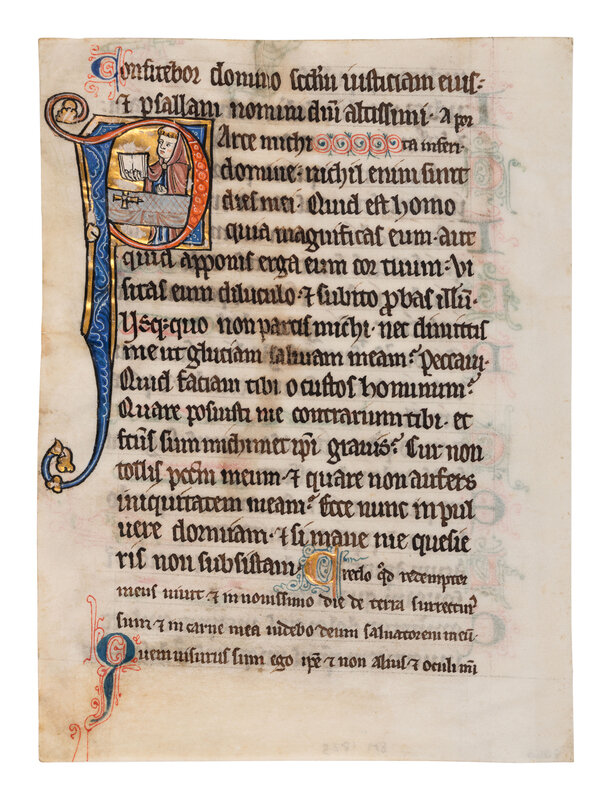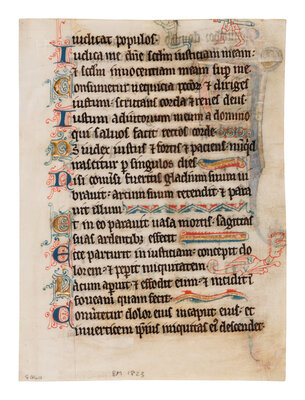Condition Report
Contact Information
Lot 11
ANONYMOUS ARTIST
A leaf from a Psalter-Hours, with a historiated initial ‘P’ of a Monk, in Latin, illuminated manuscript on parchment [Flanders or Rhine-Meuse, c. 1225-1275]
A leaf from a Psalter-Hours, with a historiated initial ‘P’ of a Monk, in Latin, illuminated manuscript on parchment [Flanders or Rhine-Meuse, c. 1225-1275]
Sale 2033 - Western Manuscripts and Miniatures
Jun 27, 2024
10:00AM CT
Live / Chicago
Own a similar item?
Estimate
$5,000 -
6,000
Lot Description
ANONYMOUS ARTIST
A leaf from a Psalter-Hours, with a historiated initial ‘P’ of a Monk, in Latin, illuminated manuscript on parchment [Flanders or Rhine-Meuse, c. 1225-1275]
A leaf from a Psalter-Hours, with a historiated initial ‘P’ of a Monk, in Latin, illuminated manuscript on parchment [Flanders or Rhine-Meuse, c. 1225-1275]
From a luxury volume made for a nun or abbess, this enchanting leaf with whimsical decoration and fine illumination comes from the famed “Rosenbaum Psalter.”
176 x 130 mm. Single leaf, ruled in plummet for one column of 20 lines (written space: 146 x 91 mm), written below top line in a gothic bookhand in brown ink, text in two sizes, verses with one-line initials alternately in blue with red penwork or in gold with blue penwork, ONE FOUR-LINE HISTORIATED INITIAL in orange and blue on burnished gold ground, with burnished gold highlights and white tracery, extending to the inner margin into spiraling tendrils, numerous line-fillers in blue, red, and burnished gold of different designs (parchment partially soiled, flakes in the gold leaf of the historiated initial, line-filler figures on the upper border of the verso trimmed, tape stains at four corners of the verso, else in good condition).
This leaf comes from an exceptionally lavishly decorated thirteenth-century Psalter-Hours, likely made for a wealthy Benedictine nun or abbess. It contains part of Matins for the Office of the Dead, reading on the recto from Psalm 7:9, “[Dominus] judicat populos…,” followed by the first lesson, responsory, and versicle on the verso, ending with “Quem visurus sum ego ipse et non alius et oculi mei.” In a large initial “P” introducing the responsory “Parce michi domine,” and on a ground of burnished gold, a monk appears holding an open book over a Cross laid on a bier. Whimsical figural line endings occur on the recto, one with a man executing a kneeling figure (cropped) and another in the form of a human-headed hybrid.
Thanks to Peter Kidd, among others, we now know quite a lot about the parent manuscript. It was lavishly illuminated with historiated initials for every Psalm, clearly for a person of considerable wealth, a nun or an abbess from a Benedictine monastery. The text of one collect refers to “the community of this holy monastery,” and the text of another refers to “our abbess.” The intercession of the Virgin Mary and St. Benedict are sought (Kidd 2019, p. 106). Its lavish illumination suggests a patron of considerable wealth, but just where the monastery was located remains open to question. Its place of origin has been much discussed – possible localization in England, the Rhine-Meuse area, Flanders, and eastern France have been postulated. The suggesting of an English origin is based in part on the type of decorative line endings, as well as other peculiarities in the cycle of illumination (Fliegel 1999, no. 12-23, from the collection of Jeanne Miles Blackburn). Kidd, Plotzek, and others favor the area of Flanders or the Rhine-Meuse region (Plotzek 1987, no. 8; Kidd 2019, no. 20, pp. 106-109).
For arguments in favor of an English origin, see the following stylistic comparisons: the Grandisson Psalter and the Salvin Hours (London, British Library, Add. MS 21926 and MS 48985; see Nigel Morgan, Early Gothic Manuscripts II: 1250-1285, London, 1988, nos. 165, 158) or the Windmill Psalter (New York, Morgan Library and Museum, MS M.102). For the Flemish or Rhine-Meuse origin, compare the group of Psalters related to Lambert le Bègue in Liege, discussed by Keith Sinclair and Judith Oliver (see especially University of Liege, Library, MS 431).
Provenance
(1) Christie’s, London, 5 December 1973, lot 80.
(2) Sam Fogg, London, 2006, acquired by:
(3) Robert McCarthy, London, MS BM 1823.
Parent manuscript
The parent manuscript was dismantled by 1966 and included, in addition to the Psalms, canticles, litany and collects, followed by the Hours of the Virgin and the Office of the Dead, a calendar and perhaps a full-page prefatory cycle. It takes its name from the provenance of many of the leaves in the Chicago collection of Esther Rosenbaum (d. 1980), sold at Sotheby’s, London, on 25 April 1983, lot 69. The large number of extant leaves from the parent manuscript allows its contents to be established in some detail. It seems that almost all psalms, hymns, prayers were introduced by a four-line historiated initial, and major texts and divisions of the Psalter by larger ones.
Sister leaves
More than forty leaves have been identified to date, and relatively complete lists of the folios are found in Sotheby’s London, July 7, 2015, lot 13 and in Peter Kidd’s Provenance Blog (see below). Leaves from this manuscript are dispersed among many private and public collections. An illuminated example is in the Cleveland Museum of Art, CMA 1999.124.7. Another leaf is in the McCarthy collection published together with the present one as no. 20a (see below).
LITERATURE
Described and published in: Christie’s, 5 December 1973, lot 80; Sotheby's, 7 July 2015, lot 13; Peter Kidd, The McCarthy Collection, Vol. II, Spanish, English, Flemish and Central European Miniatures, London, 2018, no. 20b, pp. 106-109 (with further literature); Peter Kidd, “A Lavishly Illuminated 13th-Century Psalter-Hours Made for a Nun (I and II),” Manuscripts Provenance, online, 2019. Further literature: Keith Sinclair, “Les manuscrits du psautier de Lambert le Bègue,” Romania 86 (1965), pp. 22-47; Judith Oliver, Gothic Manuscript Illuminationin the Diocese of Liège (c. 1250-c. 1330), Louvain, 1988, vol. 1, pp. 29-38.
We are grateful to Peter Kidd for permission to quote from his catalogue for this entry. Freeman’s | Hindman thank Senior Consultant Sandra Hindman and Elliott Adam for their assistance in preparing this sale.
The Collection of Robert McCarthy



